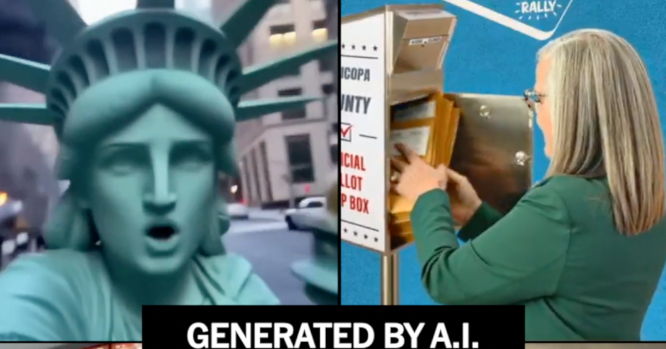Loosely organized groups of self-described right-wing trolls and “memers” have long posted flattering portraits of President Trump, portraying him as a war hero, a rock star or a muscular comic book vigilante. Their pro-Trump content, for the most part, was not heavily viewed.
Mr. Trump is bringing them into the mainstream.
Mr. Trump has been sharing memes online since his first term, but artificial intelligence has made it far easier to generate them. In recent months, Mr. Trump has reposted more than 20 A.I.-generated images and videos, some of them produced by members of online communities dedicated to sharing their experiments with the technology. One video he shared on Truth Social showed him doffing a crown like a king. Another depicted him as a fighter pilot dropping what looked like excrement on protesters.
“WOWWW!!,” the account behind the fake pilot video posted after Mr. Trump amplified it on Truth Social. “This is incredible.”
The New York Times examined the online ecosystem of A.I. aficionados who have organized into communities devoted to praising the president. Hundreds of users, posting anonymously each day, have produced thousands of artificial intelligence-powered videos and images displaying their fondness for the Trump administration and mocking the president’s enemies. Their work is often crude and sometimes racist.
Mr. Trump has, at times, reposted their work to his social feeds, catapulting the memes from the periphery of political discourse to its center and upending traditional pathways to influence.
“All of this is happening underground within these networks, without a whole lot of oversight or governance — and then Trump goes and reposts it, and instantly that gives the creator or network credibility,” said Bhaskar Chakravorti, a dean of global business at the Fletcher School at Tufts University. “It’s probably the first time we have had a sitting head of state essentially reposting and amplifying what used to be a largely contained movement.”
The White House did not comment on the president’s reposts, although a spokeswoman for the administration recently praised Mr. Trump’s use of social media to “communicate directly with the American people.”
At least a dozen of these meme groups are active on X and Discord, a messaging service popular with gamers. Their creators have met online for years and congregated in different forums, posting memes on fringe internet forums and pushing cryptocurrencies that riff on Mr. Trump’s brand. Often, those videos perpetuate harmful stereotypes about immigrant communities; many utilize racial slurs.
Even now, the groups remain obscure. They organize in private channels to share their work and troubleshoot issues. Most of their posts simply seek an audience, though some of the collectives offer their services to political campaigns or brands for a fee.
But artificial intelligence has made their content more visceral and viral. Services that can create realistic A.I. videos — such as OpenAI’s new tool Sora — have become far more powerful and accessible over the past year. Users can now create almost anything they can imagine by typing instructions into a text box, often for little or no cost.
In one group, a particularly prolific member posted a video of Mr. Trump rendered as The Punisher, a comic book character known as a violent vigilante, and seen rescuing children — a nod to a conspiracy theory about sex trafficking.
“It took about 6 to 8 hours worth of work,” the user wrote about the video on Discord.
Lately, meme collectives are expanding their reach, whether because of increased public interest in A.I. content, or a result of landing on the administration’s radar. Together as a unit, the members of Green Frog Labs, one of the loosely-organized groups on X, claim more than 300,000 followers on X and more than 100 million views of their videos, according to the group’s estimates.
“We really have some of the best memers,” said Greg Scott, an entrepreneur who set up the group earlier this year, in an interview with The New York Times.
The group has more than 90 members ranging in age from 20 to 60 (Mr. Scott is in his 40s) and quickly found success producing A.I. videos mocking one Hollywood actress and replacing people from news segments with A.I.-generated talking babies. Creators crafted videos of Mr. Trump as Patrick Bateman, the lead character of the film “American Psycho,” preparing an agenda of “vengeance and retribution,” and also as a Rambo-type figure firing sombreros out of a machine gun.
Recently, Green Frog members produced dozens of videos targeting Zohran Mamdani, the mayor-elect of New York, often leaning on religious and racial stereotypes.
“I understand people would be offended, might find it hateful,” Mr. Scott said. “It could come across as that to some people, but we’re just trying to make people laugh.”
The group also messaged a Republican congressional primary candidate in Maryland this year on X, offering their services. The candidate, Cheryl Riley, later posted multiple A.I.-generated videos created by the group, including a video of her Democratic opponent depicted as a rat.
“Thank you, you amazingly talented people,” Ms. Riley wrote to the group on one of her posts. Ms. Riley did not respond to a request for comment.
Members of Green Frog and other groups have congregated on Discord, largely anonymously, to swap tactics for bypassing content restrictions on popular A.I. apps, according to messages reviewed by The Times. They have tested the limits of mainstream tools like Sora, trying to evade guardrails meant to prevent the app from generating depictions of notable figures like Mr. Trump. As the groups’ efforts become more sophisticated, some have evolved into video production businesses.
“Little by little we’re figuring out how to use President Trump on the new Sora,” one creator posted on X in late October, alongside a video depicting an A.I. replica of Mr. Trump celebrating the end of funding for the Supplemental Nutrition Assistance Program, or SNAP.
The Trump White House has eagerly embraced A.I. as a propaganda tool, following the president’s lead in posting artificially generated content showing various Democrats in sombreros — material that Representative Hakeem Jeffries, the House minority leader and a frequent target of the videos, has called racist and bigoted.
In March, the official White House account on X faced backlash after sharing an A.I.-generated image of immigration officers arresting a woman who was previously convicted of trafficking the drug fentanyl. Kaelan Dorr, the deputy communications director at the White House, wrote on X that people seemed more upset about the A.I. image than they were about the fentanyl crisis.
“The arrests will continue,” he wrote. “The memes will continue.”
Stuart A. Thompson writes for The Times about online influence, including the people, places and institutions that shape the information we all consume.
The post Trump Elevates Once-Fringe Meme Makers to the Mainstream appeared first on New York Times.




